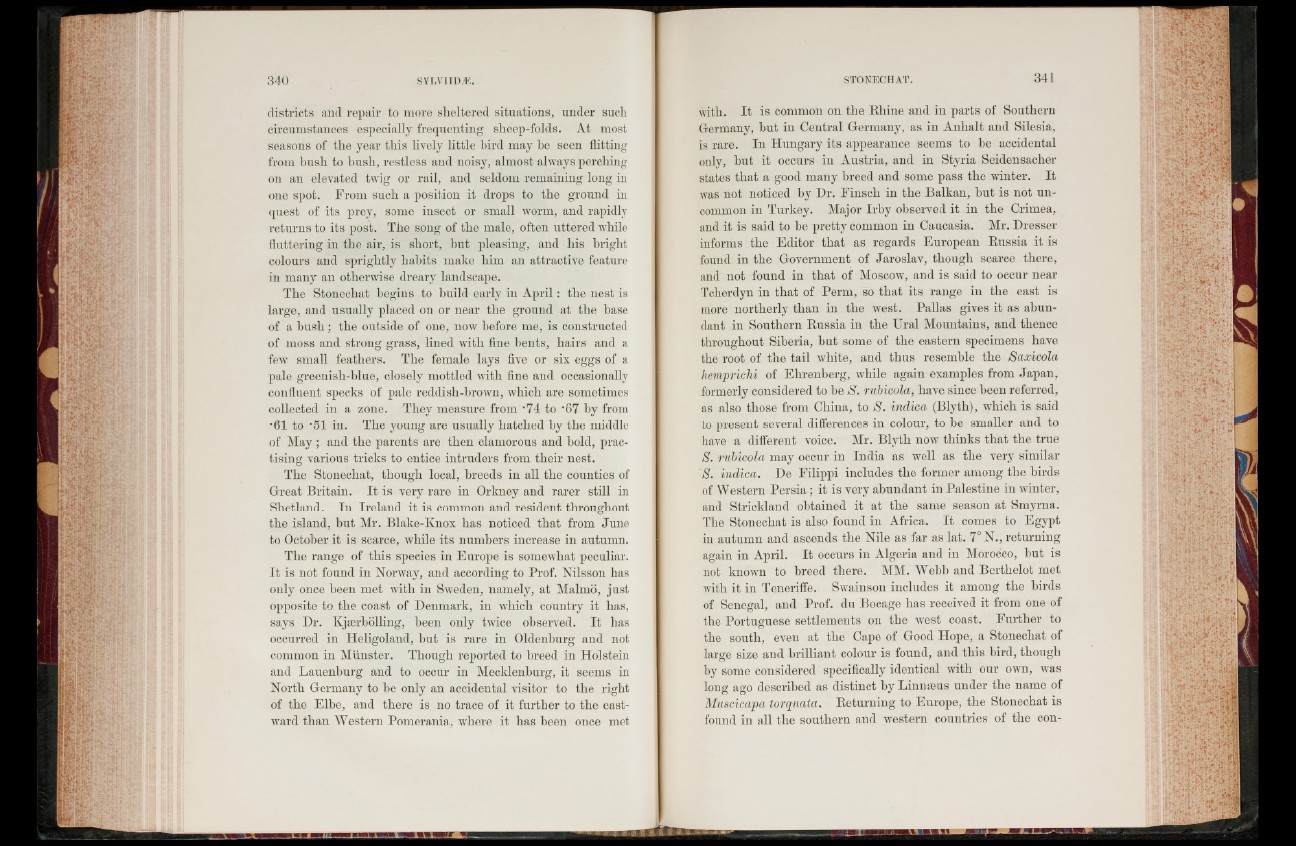
districts and repair to more sheltered situations, under such
circumstances especially frequenting sheep-folds. At most
seasons of the year this lively little bird may be seen flitting
from hush to hush, restless and noisy, almost always perching
on an elevated twig or rail, and seldom remaining long in
one spot. From such a position it drops to the ground in
quest of its prey, some insect or small worm, and rapidly
returns to its post. The song of the male, often uttered while
fluttering in the air, is short, hut pleasing, and his bright
colours and sprightly habits make him an attractive feature
in many an otherwise dreary landscape.
The Stonechat begins to build early in A p ril: the nest is
large, and usually placed 011 or near the ground at the base
of a h u sh ; the outside of one, now before me, is constructed
of moss and strong grass, lined with fine bents, hairs and a
few small feathers. The female lays five or six eggs of a
pale greenish-blue, closely mottled with fine and occasionally
confluent specks of pale reddish-brown, which are sometimes
collected in a zone. They measure from -74 to -67 by from
•61 to ‘51 in. The young are usually hatched by the middle
of May ; and the parents are then clamorous and hold, practising
various tricks to entice intruders from their nest.
The Stonechat, though local, breeds in all the counties of
Great Britain. I t is very rare in Orkney and rarer still in
Shetland. I 11 Ireland it is common and resident throughout
the island, but Mr. Blake-Iinox has noticed that from June
to October it is scarce, while its numbers increase in autumn.
The range of this species in Europe is somewhat peculiar.
It is not found in Norway, and according to Prof. Nilsson has
only once been met with in Sweden, namely, at Malmö, just
opposite to the coast of Denmark, in which country it lias,
says Dr. Kjserbölling, been only twice observed. I t has
occurred in Heligoland, hut is rare in Oldenburg and not
common in Miinster. Though reported to breed in Holstein
and Lauenburg and to occur in Mecklenburg, it seems in
North Germany to he only an accidental visitor to the right
of the Elbe, and there is 110 trace of it further to the eastward
than Western Pomerania, where it has been once met
with. It is common on the Khine and in parts of Southern
Germany, hut in Central Germany, as in Anhalt and Silesia,
is rare. In Hungary its appearance seems to be accidental
only, hut it occurs in Austria, and in Styria Seidensaclier
states that a good many breed and some pass the winter. It
was not noticed by Dr. Finscli in the Balkan, but is not uncommon
in Turkey. Major Irby observed it in the Crimea,
and it is said to he pretty common in Caucasia. Mr. Dresser
informs the Editor that as regards European Russia it is
found in the Government of Jaroslav, though scarce there,
and not found in that of Moscow, and is said to occur near
Tcherdvn in that of Perm, so that its range in the east is
more northerly than in the west. Pallas gives it as abundant
in Southern Russia in the Ural Mountains, and thence
throughout Siberia, hut some of the eastern specimens have
the root of the tail white, and thus resemble the Saxicola
hemprichi of Ehrenberg, while again examples from Japan,
formerly considered to he S. rubicola, have since been referred,
as also those from China, to S . indica (Blyth), which is said
to present several differences in colour, to be smaller and to
have a different voice. Mr. Blyth now thinks that the true
S. rubicola may occur in India as well as the very similar
S. indica. De Filippi includes the former among the birds
of Western P ersia; it is very abundant in Palestine in winter,
and Strickland obtained it at the same season at Smyrna.
The Stonechat is also found in Africa. I t comes to Egypt
in autumn and ascends the Nile as far as lat. 7° N., returning
again in April. I t occurs in Algeria and in Morocco, hut is
not known to breed there. MM. Wehb and Bertlielot met
with it in Teneriffe. Swainson includes it among the birds
of Senegal, and Prof. du Bocage has received it from one of
the Portuguese settlements on the west coast. Further to
the south, even at the Cape of Good Hope, a Stonechat of
large size and brilliant colour is found, and this bird, though
by some considered specifically identical with our own, was
long ago described as distinct by Linnaeus under the name of
Muscicapa torquata. Returning to Europe, the Stonechat is
found in all the southern and western countries of the con